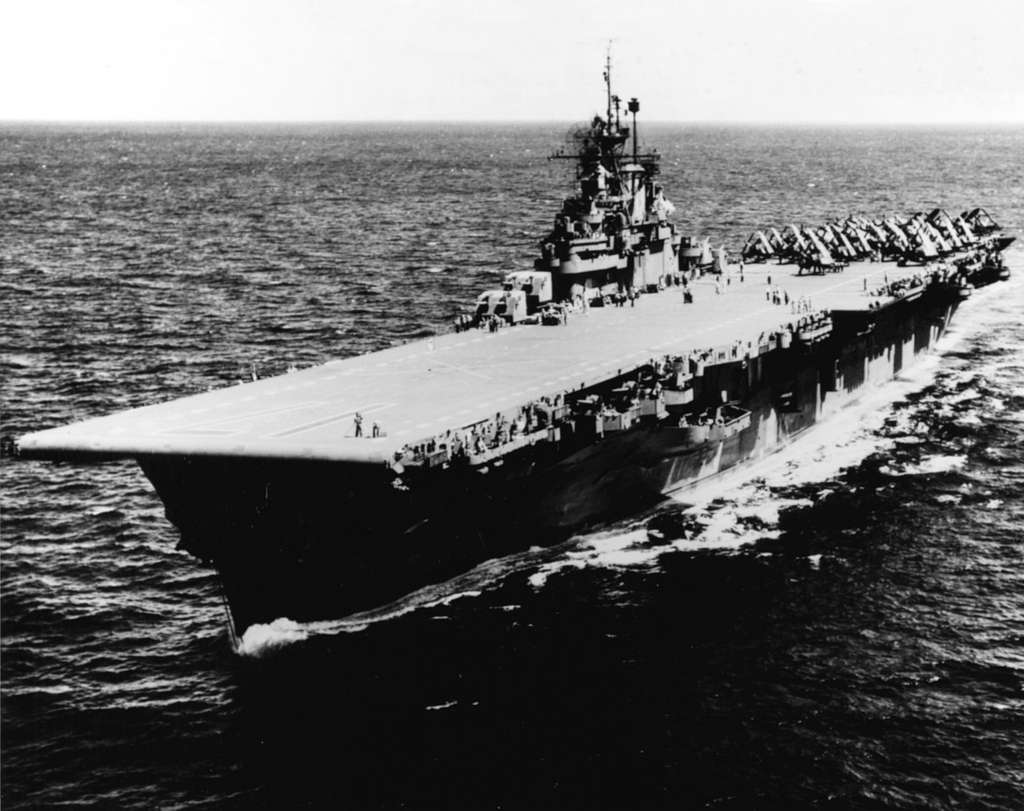
The USS Bunker Hill (CV-17), nicknamed “Holiday Express,” was ordered for the U.S. Navy before World War II. Her keel was laid down at Bethlehem Steel Company on September 15, 1941. She was launched on December 7, 1942 and commissioned on May 24, 1943 under the command of Captain J.J. Ballentine.
USS Bunker Hill joined World War II combat at the end of 1943. She took part in operations on Rabaul, the Gilbert Islands, Tarawa, Kavieng, the Marshall Islands, Truk, the Mariana Islands, Palau, Yap, Ulithi, Woleai, Satawan, Ponape, and Hollandia. The carrier was also involved in the Battle of the Philippine Sea, a decisive victory for American forces.
During the battle at the Mariana Islands on June 19, 1944, an enemy near-miss damaged the carrier when fragments of shrapnel scattered across the ship. Two men died and over 80 others were injured, but the carrier maintained her position and continued to shoot down Japanese aircraft and help sink an enemy carrier.
The USS Bunker Hill joined in the Western Caroline Islands campaign in September. She conducted air strikes against Okinawa, Luzon, and Formosa until November before returning to Bremerton for repairs. When her repairs were completed, she headed back to the battle zone in time for the Battle of Iwo Jima, the assaults on Honshu and Nansei Shoto, and the Battle of Okinawa. Her aircraft attacked Japanese forces in the East China Sea on April 7, 1945 as a part of operation Ten-Go, helping to bring down the Japanese battleship Yamato, a cruiser, and four destroyers.
As the USS Bunker Hill supported the invasion of Okinawa on May 11, 1945, she was hit by two kamikazes. The first kamikaze dropped a bomb that fell through the ship and detonated under water before crashing into the flight deck. The second kamikaze dropped a bomb that went through the flight deck and exploded before the plane crashed into the flight deck near the control tower. Along with the resulting fires and explosions, 346 men were killed, 43 went missing, and 264 others were injured.
USS Bunker Hill was able to sail to Puget Sound Naval Shipyard for repairs via Pearl Harbor. Once repair work was done, she aided in Operation Magic Carpet, bringing American troops home from war. She was then decommissioned on January 9, 1947.
The USS Bunker Hill was reclassified three times, first as CVA-17 in October 1952, then as CVS-17 in August 1953, and finally as AVT-9 in May 1959. She did not see active duty again. The carrier was struck from the Naval Vessel Register on November 1, 1966. She served as a stationary electronics test platform in the 1960s and 1970s before being sold for scrap in May 1973. The USS Bunker Hill earned 11 battle stars and a Presidential Unit Citation for her service in World War II.
Like all other vessels from the World War II era, the USS Bunker Hill was built using many asbestos-containing materials. The toxic substance asbestos was known for its resistance to water, fire, heat, and corrosion. Because of this, it could be found in boilers, pumps, steam pipes, hot water pipes, caulking, valves, electrical wiring, gaskets, incinerators, turbines, wall insulation, engine rooms, floor and ceiling tiles, rope, and sealants. Anyone who served aboard the USS Bunker Hill or was involved in her repair and overhaul was exposed to dangerous levels of asbestos without the benefit of protective clothing or respiratory gear. This put them at risk of developing serious asbestos-related illnesses like lung cancer, asbestosis, throat cancer, stomach cancer, colon cancer, rectal cancer, and mesothelioma, an aggressive form of cancer that affects the protective lining that surrounds the lungs and other organs.
USS Bunker Hill workers should monitor their health carefully, and consult a doctor if they experience any symptoms associated with mesothelioma. Anyone who worked on or around the USS Bunker Hill, and is diagnosed with mesothelioma, should also consider contacting a lawyer to discuss their legal rights.
